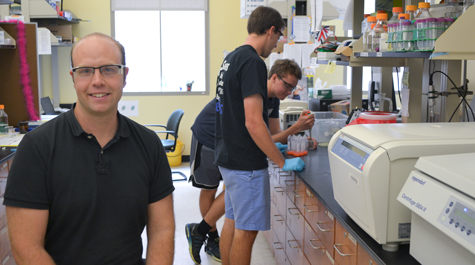A Henry Dreyfus Teacher-Scholar explains unnatural amino acids
Doug Young works in an area where the worlds of chemistry, biology and engineering meet, focusing on a class of molecules known as “unnatural amino acids.”
“The basis of all life is the cell. And within the cell, the major functioning group is all the proteins,” he said. “As a chemist, what blows my mind is the fact that all of our proteins are made up of only 20 amino acids.”
Those 20 building blocks of the hundreds and thousands of proteins that do the work inside the cells of all living things are the “natural” amino acids, Young explained.
“In our lab, we think about all the cool things proteins do,” he said, “and we ask ourselves, what if we could give the proteins a bigger toolbox?”
Young is an associate professor in William & Mary’s Department of Chemistry. He enlists a rolling retinue of students, graduate and undergraduate, in his lab’s quest to expand the toolbox of proteins, work that has important implications for a wide range of fields, notably cancer therapeutics.
For his successes in incorporating teaching and research, Young was named a 2017 Henry Dreyfus Teacher-Scholar by the Camille & Henry Dreyfus Foundation.
“I suspect that we may be the most successful chemistry department in the country with regards to the number of Henry Dreyfus Teacher-Scholar awards granted,” said Rob Hinkle, professor of chemistry and chair of the department at William & Mary.
Hinkle, who was a member of the 2002 class of Henry Dreyfus Teacher-Scholars, is correct. Young’s award makes him the seventh William & Mary chemist to hold the honor. No other school has more than six, and all seven of William & Mary’s Henry Dreyfus Teacher-Scholars are still on the chemistry faculty.
In addition to Young and Hinkle, the chem department has Henry Dreyfus Teacher-Scholars in Jonathan R. Scheerer (2015), Elizabeth Harbron (2010), J.C. Poutsma (2006), Robert D. Pike (1999) and Christopher J. Abelt (1996). An eighth is Myriam Cotten, an associate professor in the Department of Applied Science, who became a 2014 Henry Dreyfus Teacher-Scholar at a previous position at Hamilton College.
Each awardee was recognized for excellence in combining education and research. Young is one of seven recipients of the award in 2017, which honors faculty at primarily undergraduate institutions. The award comes with an unrestricted research grant of $60,000.
"Research support at undergraduate institutions is very important," stated Mark J. Cardillo, executive director of the Camille and Henry Dreyfus Foundation, in a press release announcing the 2017 honorees. "Nearly half the chemists who earn a doctorate degree receive their bachelor's degree from an undergraduate institution, and research is a fundamental part of chemistry education."
Young and the students in his lab use unnatural amino acids to engineer designer proteins.
“We synthesize unnatural amino acids that aren’t part of that base set of 20 and then we kind of trick bacteria or yeast — or even mammalian cells — into putting our unnatural amino acid into the protein,“ he explained. “So now you get all this new chemical functionality in this really useful protein.”
The lab’s work is part an emerging area of biochemistry known as immunotherapeutics, a field that holds great promise for new cancer treatment options.
“A lot of times, cancer drugs used in chemotherapies just target any cell that’s rapidly dividing,” Young said. “That’s why you get a lot of the bad side effects — the loss of hair, the sickness — that come with chemo.”
He explained that the immunotherapeutic approach is to pair an unnatural amino acid with an antibody and a cancer drug. The antibody is a special protein that recognizes cancer cells and can deliver the drug directly to the cancer cell — and only to the cancer cell, reducing or eliminating side effects associated with traditional chemotherapy.
“If you try this with natural amino acids, you run into problems because you get these really complex situations because there is so much reactivity,” Young explained. “We try to create reactions that don’t exist in biological systems, so the only place things can react is where we want them to.”
Young has B.S. degrees in biology as well as chemistry, ideal background for a professor mentoring undergraduates in a biochemistry lab. He said he has 14 to 16 students working in his lab at any given time when classes are in session, each working around three to four hours a week.
“In the summer, I usually have six or seven students,” he added. “But they’re here all the time.”
Most members of his lab are chemistry majors, but he said he also gets quite a few biology and neuroscience majors. They typically join in their freshman year and the more experienced students guide the noobs through the foundational work.
“We’ll show you how to express a protein or how to set up a reaction. It takes six months to a year to get to a level of comfort in the lab,” he said.
After comfort level has been achieved, Young gives students their own projects. Some students even come up with their own research projects, he said, often evolving into senior honors projects.
“It’s all related to what I do, to my research,” Young said. “But to see them come up with their own part of it, and move forward by themselves — you know, it’s a very neat thing to watch.”
 Skip to main content
Skip to main content

